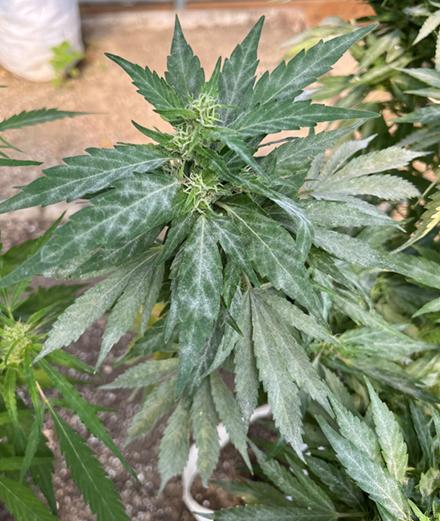ARS Scientists Provide Insight into an Age-Old Crop

Powdery mildew on a hemp plant.
New Rules on Hemp Production Spark Research to Help Growers
Agriculture has been around for about 10,000 years, so it's not often that scientists are called on to conduct research on a new crop. However, when the 2018 Farm Bill reversed a 50-year-old federal ban on growing hemp, and Congress subsequently appropriated funding to study it, that's exactly what happened. Suddenly, researchers were asked to help growers fight diseases of hemp and mitigate the damages they cause.
As a crop, hemp is not exactly new – its first recorded cultivation was nearly 5,000 years ago in China. However, due to the 1970 ban, researchers in the United States have not had much opportunity to work with it until now.
"Hemp is a relatively new crop for us to work on in the United States, therefore, we don't know what sort of plant diseases it might be susceptible to in Oregon, the Pacific Northwest (PNW), and the rest of the country," said Hannah Rivedal, plant pathologist with the Agricultural Research Service (ARS) Forage Seed and Cereal Research unit in Corvallis, OR.
ARS researchers there are partnering with colleagues at Cornell University, Alabama A&M, Oregon State University, University of California-Davis, the University of Wisconsin, and many other institutions to optimize hemp production and help hemp growers find new and existing markets for this new crop.
Farmers in the PNW grow crops related to hemp, such as hops, that may help scientists understand what potential pathogens could affect hemp and how they might impact or cause disease in other crops in the region. To better understand current diseases of hemp, research teams are visiting fields and surveying plants throughout the growing season over 3 years, beginning in 2021.
Rivedal said that what they learn about pathogens that affect hemp will both educate growers about the diseases they should monitor and inform future research efforts.
"Agriculturally, this is an important study so that we can understand the types of management challenges a hemp grower may face," Rivedal said. "Disease management is a costly challenge to growers and plant diseases can reduce yields. We want our growers to be able to produce the best product they can with the lowest costs."
ARS researchers also want to know how diseases of hemp might affect other crops and impact yield and production costs. "We have identified several diseases, including fungal pathogens that cause diseases like powdery mildew, fusarium root and crown rot, and botrytis bud rot," Rivedal said.
The researchers have also identified pathogens that cause curly top disease and "dudding" disease, which causes stunted growth, brittle stems, and less flower mass. In addition, they have found root lesion nematodes associated with hemp roots and soil, though, in general, the sizes of plant parasitic nematode populations have been low.
The presence of these pathogens in hemp is a concern because hemp could act as a vehicle for pathogens to infect other crops. "We will continue to investigate this concern through our survey and in future research efforts," she said.
Hemp is treated differently in a legal sense from recreational or medicinal marijuana. Even though they come from the same cannabis species, the legal difference is the amount of tetrahydrocannabinol (THC) the plant contains. If the cannabis plant contains more than 0.3% THC, it is considered marijuana. Medical or recreational marijuana cannot be produced legally with a hemp license.
Industrial uses of hemp include clothing and shoes; ropes and nets; paper and building materials; biofuel; and food products and beauty products.
"What's really exciting about this project is the fact that production of this crop in the United States has been restricted for so long that it's basically brand new," Rivedal said. "It's exciting to be teasing out the pathogens of hemp since it has not been done in many years. So, there's a lot to learn and understand, which is exciting to me."
Visit the USDA website for information on the Hemp Production Program. – By Scott Elliott, ARS Office of Communications

